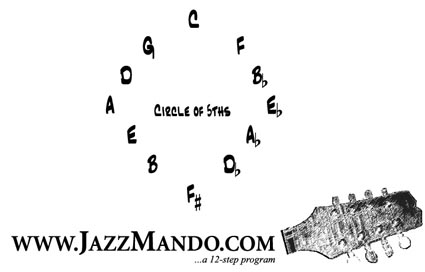« March 2012 |
Main
| May 2012 »
 April 26, 2012 | Posthumous tips from John McGann
April 26, 2012 | Posthumous tips from John McGann
We were saddened by the recent loss of John McGann, Boston educator/philosopher and talented multi-instrumentalist. A consolation though, many of his tips and ideas remain in his books and on his personal website, a terrific resource for any fretted musician. He also shared generously some of his concepts on a frequent basis on the Mandolin Cafe forum, one from six years ago detailed his personal journey, and ultimately victory over what he considered a debilitating playing weakness, entitled "How My Life Was Changed."
At first glance, the heading appeared melodramatic, but anyone who has pursued a disciplined struggle to get better tone and technique will agree energy invested in correcting these weaknesses pays long term dividends royally. With the undeniably great results of John's mastery, you have the proof! We found it encouraging, and wanted to share it with you. The text below is a complete reprint.
John, we miss you...

John McGann 1959-2012
"Back around 1980 I graduated from Berklee, where my main focus was on learning theory and composition. I could play OK but my tone and technique were "not happening", and I couldn't figure out why I couldn't get a sound approaching that of my heros. So, I decided to call Andy Statman and arrange a lesson.
That was the only lesson I ever took on mandolin. Andy got me thinking VERY seriously about my right hand. I was clenching my fingers in, which was limiting my movement. He showed me and got me thinking of ways to get gravity working for me, to make the act of playing much easier than the struggle I was going through.
My left hand was the "flying fingers" syndrome- rather than keeping the fingers down as I ascend the string, I would lift each finger under the new note on the string. As the link below details, this makes about 80% more work for yourself .
I have detailed a bunch of right and left hand technique ideas collected from my experiences both with Andy and from casual "picking the brains" of other great players here.
After the lesson, I went to a hardware store and bought a long vertical mirror. I put it in my practice room so I could watch my hands. I took me three months, practicing untold hours, to get the new techniques to become automatic. During this period, I was playing bluegrass 2 to 4 nights a week in bars- where, of course, in an effort to keep up with the fast tempos, the new techniques would fall to shreds and I'd be back hacking away.
After the 3rd month, I began to be able to deal with the new way of playing on the gig as well (lots of metronome practice!). From here, I went on to winning regional mando contests and eventually Winfield.
The point of my post is to say that if you are willing to work hard at the right stuff, you can really change your musical life. The first point is that you need to feel unsatisfied with your playing (I still do and hope I always will- that's how you keep growing!).
The second step is to find a great teacher who is a great player. The combination is rare.
The third thing is to enjoy the ride. You'll probably be looking at long hours of dedicated practice- but you will get results in a relatively short time (I could do three months in prison if it made me a better player!)
I hope this post may be of some help to folks who get down on themselves for "lack of talent". I consider myself the product of hard work much more than talent.
Further:
10 Questions for John McGann
Recommended exercise: Lydian DUDU
Berklee Faculty Profile
Fiddling with Flying Fingers
Fear of Flying
Posted by Ted at 9:19 AM
 April 19, 2012 | FFcP vs Closed Fingerings Scales
April 19, 2012 | FFcP vs Closed Fingerings Scales

We get some great questions and very much enjoy sharing them with you. Here's a critical one, and got us thinking it might be time for a little review on the FFcP concept:
"Pardon my naivety, but I've kept hearing about this ffcp thing so I just looked it up... given that I'm at work with no mandolin to try this on I'm probably missing something here, but what separates ffcp from just learning closed scale patterns and arpeggios? I've certainly still got plenty to learn, but I already do closed scales up and down the fretboard using my pinky (playing cello really helps this too...) what is the concept that separates ffcp from that?"
Learning the scales in closed position is a great way to attack the fretboard, but in doing so, you're addressing 12 (15 if you count enharmonic) different fingerings. A, Bb, B/Cb, C, Db/C#, D, Eb, E, F, F#/Gb, G, Ab. There's legitimacy in learning these with the context of songs (we encourage this!), but we've taken a step back from the intellectual and pushed the motor, the "feel" of the scale, and reduced it to the four simple tactile relationships.
For review, read the Introduction to FFcP on the Mandolin Cafe Lessons Page.
From the introductory materials: "The perfect 5th tuning of the mandolin offers a truly unique opportunity; moving a scale or pattern up a string or two, up several frets, yet easily maintaining the relation with only four possibilities, a scale based on fingers 1, 2, 3, or 4. This is the whole basis of the FFcP approach." Note that if you're playing sax, piano, or even guitar, you don't have this advantage.
"We first need to limit the fingering to just these four possibilities. As you study these, understand we are building roadmaps, or better, "wagon trail ruts" of where to intuitively place your fingers during improvisation. Along the way, you'll enjoy the healthy by-product of a useful, limber 4th finger (pinky). And eventually abandon the fear of moving everything up the frets into the fertile potential of the mandolin's higher positions."
In addition to the simple eight note scale pattern, we introduce some interval relationships. We also sneak in skill identifying which notes are critical in defining tonality and creating tension and resolution. You might not recognize it now, but after months of drilling, you'll find some of the tactile motions will occur intuitively in your improvisation.
Be patient, though!

FFcP Part 2
Review: Principles of FFcP
- In this system, there are only four ways to play a major scale: starting with the first finger, the second, the third and the fourth. That's it!
- All 12 keys can be covered in only four different positions, simply by transposing up or down the fretboard and across strings.
- 4th Finger (Pinky) strength and coordination become part of daily development exercises.
- Key Chord Tone relationships in improvising become tactile, visible, and intuitively real.
- Position shifts to a second octave are easily bridged merely by starting the next octave with a different FFcP pattern.
- Changes in tonal "micro-centers" by half steps easily transist either by moving the pattern by one fret, or using the next FFcP.
- Open string "opportunities" will be explained and added later, but only after mastering the FFcP system.
Further:
The Jazz Brain; Improv
Notes on your fretboard. Coming out of nowhere
Calisthenics and mandolins
Math, eggs, and mandolins; higher level understanding/a>
Fingers, Ears, Brain
Posted by Ted at 1:52 PM
 April 12, 2012 | Tenor banjo and chord melody
April 12, 2012 | Tenor banjo and chord melody
Chord melody orchestrating on a solo mandolin is an approach that can be both entertaining and vexing at the same time. We marvel at the pros who do it so well, Don Stiernberg, Jethro Burns, Aaron Weinstein, Pete Martin, and scratch our heads at how they can be so adept at communicating vertical (chord) structure in addition to horizontal (melody) simulatenously.
We've attempted to unravel this a few times, and recently stumbled across a great resource over at the Deering Banjo website. Chord melody is an important facet of a good tenor banjoist which of course, is tuned in 5ths like the mandolin, and exactly the same as a mandola (North American version), CGDA. This makes for an easy comparison. (Hint: Check for vintage tenor banjo method books for some great instruction...)
We don't need to repeat the details here, David Bandrowski does an excellent job of dumbing it down for us with some great video excerpts, on a tune you probably already know. The trick? Three simple steps:
1. Learn a melody on one string, the highest, and horizontally up the fretboard.
2. Learn inversions of common chords. As we've mentioned before, 3-note chords are enough, and this frees you for a 4th voice to express melody
3. Put them all together
Simple? It can be when you break it down this way.
Check it out: Tenor Banjo Lesson - How To Build A Chord Melody

By the way--if you've ever considered purchasing an entry level 4-string tenor banjo, we highly recommend Deering's Goodtime Tenor Banjo for tone and value.
Further:
Building blocks for mandolin chord melody
More Three-note chords to supercharge your comping
More mandolin chord melody virtuosity from Aaron Weinstein
Bridging Chord Melody
Scratching the Surface of Chord Melody Playing on the Mandolin
Tips and Tricks--Chords up our sleeves
Posted by Ted at 8:51 AM
 April 5, 2012 | Best of JM: World Dominants
April 5, 2012 | Best of JM: World Dominants
Enjoy the popular archive material below.
From February 28, 2011 | World Dominants"
We hope you've been able to keep up with this. Our recent Tips and Tricks entry is the second of a three part series on mandolin 3-note fingerings of the V7 chord. What's great about this is how comprehensive this is in tapping the potential of the crucial component of the Tonal Universe up and down the fretboard. The first week we looked at the four blocks (yes, that's it! Only four to learn!). The second installment covered how we can smoothly progress from one to the next in a Circle of Fifths progression.

We can't stress enough how crucial these fingerings are, let alone how competent familiarity can inject intuitive freshness into your comping. Next week we'll look at the passing chords you can inject between, in order to get even more fluidity into your background accompanying.
Read Articles:
3-note Chord Dominants; Part 1 (Inversions)
3-note Chord Dominants; Part 2 (Circle of Fifths)
   
Posted by Ted at 4:16 AM

Disclaimer: In the 'Information Age' of the 21st Century,
any fool with a computer, a modem, and an idea can
become a self-professed 'expert." This site does not
come equipped with 'discernment.'
|



